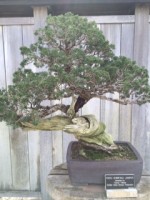 Chinese juniper is an evergreen coniferous tree or shrub native to Asia but is widely grown as an ornamental. It is a member of the cypress family, Cupressaceae, that also includes redwood, sequoia, cedar, and arborvitae. Plants may have two kinds of leaves, scale-like or needle-like. They usually produce male and female reproductive parts on different plants and have blue-black berry-like cones with a waxy bloom and two to four seeds. In the mountains of Japan they often have gnarled and twisted trunks and branches with large areas of exposed dead wood that is particularly suitable for jins and sharis. Chinese juniper can be shaped into almost any style. The cultivar ‘Shimpaku’, is one of the most popular cultivars for bonsai. It is a slow growing dwarf native to Japan and has beautiful bark and foliage.
Chinese juniper is an evergreen coniferous tree or shrub native to Asia but is widely grown as an ornamental. It is a member of the cypress family, Cupressaceae, that also includes redwood, sequoia, cedar, and arborvitae. Plants may have two kinds of leaves, scale-like or needle-like. They usually produce male and female reproductive parts on different plants and have blue-black berry-like cones with a waxy bloom and two to four seeds. In the mountains of Japan they often have gnarled and twisted trunks and branches with large areas of exposed dead wood that is particularly suitable for jins and sharis. Chinese juniper can be shaped into almost any style. The cultivar ‘Shimpaku’, is one of the most popular cultivars for bonsai. It is a slow growing dwarf native to Japan and has beautiful bark and foliage.
Position: Chinese juniper should be grown outdoors in full sun. They tolerate some shade and will be richer in color but slower to start growing in spring. In the winter protect the plant when the temperatures dip below 14 F by moving it into an unheated garage or similar area. The foliage may turn bronze in the winter but will return to green in spring.
Water: Junipers don’t like wet soil so water lightly in summer and be especially careful not to over water in the winter. Mist the foliage regularly especially in the summer and after repotting.
Fertilizer: Use a well balanced fertilizer at half strength every two weeks from early spring to mid summer but a low to no nitrogen thereafter. Do not fertilize plants in very hot weather or two to four weeks after repotting.
Repotting: Repot every two to five years in mid-spring; younger plants needing repotting more frequently than older ones. Remove no more than 1/3 of the roots when root pruning. Place the plant in the shade for a month, mist daily, and do not fertilize.
Soil: Use a standard soil mix with an addition of 20% finely chopped fresh sphagnum moss
Pruning: Prune branches and old shoots in late summer when the sap is no longer rising. Pinch out the growing tips and cut back new shoots to the leaf pads when they have grown one to two inches. The foliage has to be thinned out periodically but make sure there are always some leaves on each branch.
Wiring: Junipers are resistant to wiring so young branches may take a year or two to set while older branches may never set. Wire in autumn or early winter and check the wires during the growing season to avoid damage.
Propagation: Heel cuttings of side shoots in autumn